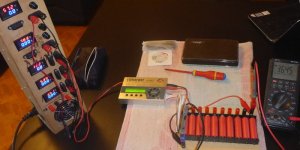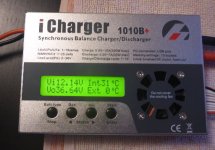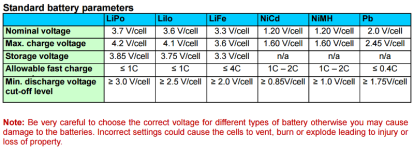Bouteille51
100 mW
Hello all,
after getting great piece of advice from the forum I selected the battery technology suited for my ebike (Li-ion), and bought cells (Sanyo NCR 18650GA) to build my battery pack (14s5p).
The pack will be built for my ebike (phaserunner + MacMotor), and designed for a max output current of 30A (6A/cell ~= 1.71C). I will use a 35A BMS from Bestech.
I will open a new topic concerning the physical build of the battery pack, but today I am concerned with the selection of cells to put together in parallel groups.
In this matter, I built a small board able to fit 10 cells in series (10s) that I connect to my balance charger (iCharger 1010b+).

The plan is to test each cell characteristics, eventually connect the charger to the computer to plot charge/discharge curves, and balance them properly before connecting them together (it is better to avoid brutal self-balance right ?).
I would now need some advice on how to select the best cells to put together.

After connection, I can use the charger to monitor individual cell voltage and internal resistance.
View attachment 1
However I wonder whether this information is enough to select the group of cells, or whether I should get more information (plots) by doing a charge/discharge cycle ?
I will try to figure out the connection with the computer to extract plots but what parameters would you recommend for such "benchmark cycle" on these cells ?
On a side note, this charger has different lithium configurations to start from, but nothing ready to use for Li-ion cells (or does it ?).
Looking at the table of pre-configured characteristics, I plan to select Lilo (I like to stop before 4.2v to save number of cycles, but all these values can actually be customized).

Do they actually mean Li-ion with "Lilo" ? :?
Does the whole strategy sound correct ?
For those of you familiar with this charger, do you know whether the balance charge program actually balances around existing voltage or whether it goes up to full (or nominal) charge ?
Ok that's already a lot of questions for a first post, I keep other ones for later
Thank you very much for your help !
after getting great piece of advice from the forum I selected the battery technology suited for my ebike (Li-ion), and bought cells (Sanyo NCR 18650GA) to build my battery pack (14s5p).
The pack will be built for my ebike (phaserunner + MacMotor), and designed for a max output current of 30A (6A/cell ~= 1.71C). I will use a 35A BMS from Bestech.
I will open a new topic concerning the physical build of the battery pack, but today I am concerned with the selection of cells to put together in parallel groups.
In this matter, I built a small board able to fit 10 cells in series (10s) that I connect to my balance charger (iCharger 1010b+).

The plan is to test each cell characteristics, eventually connect the charger to the computer to plot charge/discharge curves, and balance them properly before connecting them together (it is better to avoid brutal self-balance right ?).
I would now need some advice on how to select the best cells to put together.

After connection, I can use the charger to monitor individual cell voltage and internal resistance.
View attachment 1
However I wonder whether this information is enough to select the group of cells, or whether I should get more information (plots) by doing a charge/discharge cycle ?
I will try to figure out the connection with the computer to extract plots but what parameters would you recommend for such "benchmark cycle" on these cells ?
On a side note, this charger has different lithium configurations to start from, but nothing ready to use for Li-ion cells (or does it ?).
Looking at the table of pre-configured characteristics, I plan to select Lilo (I like to stop before 4.2v to save number of cycles, but all these values can actually be customized).

Do they actually mean Li-ion with "Lilo" ? :?
Does the whole strategy sound correct ?
For those of you familiar with this charger, do you know whether the balance charge program actually balances around existing voltage or whether it goes up to full (or nominal) charge ?
Ok that's already a lot of questions for a first post, I keep other ones for later
Thank you very much for your help !

